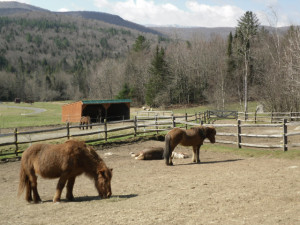
Mud season in Vermont is not kind to people who love to play outdoors. But horse riding is a great adventure, and when it comes to spring time, adventures are what you need to get body and soul through Mud Season. That’s our current theory, and to test it, my friend Muffy and I set up a trail ride at the Vermont Icelandic Horse Farm in Fayston, VT, about an hour’s drive due south from where we live at the western edge of Mt. Mansfield. It was also our spring adventure. Did we enjoy it? Did it inspire us? Will we want to ride Icelandics again in other seasons, you might ask? You, Dear Reader, will have to read on to find our answers to those questions, and decide if an adventure like this might be right for you . . .
Ok, first we want to get this out in the open; Muffy and I are both experienced horsewomen. So we have to admit that, more than just the chance to ride, we were intrigued by the idea of riding Icelandic Horses, a 900-year-old breed we’ve only encountered through picture books, regional horse expositions and more importantly. . . hearsay! We thought it would be a lark to get up close and personal with the critters, compare the reality to all we’d heard about their quiet natures, their terrific work ethic, and their calm, easy going demeanor. How would they rank against animals we had owned and ridden in our combined 90 years (can that be right?!?) of riding? And, more importantly, how well did we think Active Families and, especially, beginner riders would fare riding one of these creatures for the very first time?
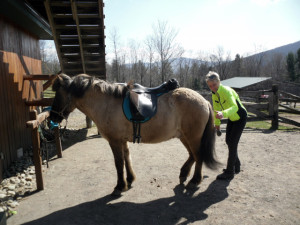
Getting a Leg Up on An Icelandic Horse
We pulled up to the Vermont Icelandic Horse Farm in the Mad River Valley late on a Monday morning. We poked our heads into the barn and Lucy greeted us. “Karen will be right here to take you out,” she called cheerily as we signed our lives away on the requisite release forms. Lucy was mucking stalls and had already tacked up the two mounts we were to ride: Skotta and Rauthka.
One thing you learn quickly about Icelandic horses is that their names are nearly unpronounceable – unless, of course, you try really really hard to wrap your tongue around the sounds. At birth they receive a “first” name which describes them in some way, and a last name which is usually the name of the farm where they were bred. Muffy was to ride Skotta (rhymes with the way someone with a thick Boston accent would say “motor”) which means both ‘good witch’ and ‘horse with mane and tail of different colors’. I was to ride Rauthka (trill the r and rhyme it with vodka) which means ‘red mare’.
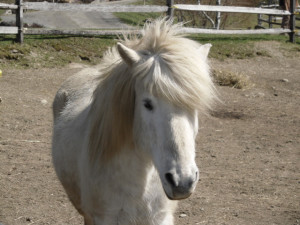
Both creatures had kind eyes and perky little ears with mops of mane, tail and forelock (hair on the forehead) making them appear, well, kinda goofy, like over-watered Chia pets. Muffy pulled out her native Vermontese and called them “wicked cute!” On their tip toes they stood about 13 hands high, which is approximately 52″-56″ from the ground to the withers (where the neck smooths out onto the back). They stood both small and narrow, but I’d read they can carry a person up to 225 pounds. What strong critters they must be, I mused. Together Muffy and I wouldn’t reach that poundage and for a moment I chuckled at the thought that the two of us would only require one horse!
Karen Winhold, the owner and operator of Vermont Icelandic Horse Farm since 1988, appeared and we also met Shirley Bate, a professional reading tutor who boards her horse with Karen and was joining us for the trail ride. We had asked to be treated like any other riders showing up for the first time, and Lucy helped Muffy and me mount our steeds. I don’t know about Muffy, but I felt kinda foolish having a groom hold my horse while I climbed up a block to swing into the saddle, like a rank beginner. I’m used to handling my own pony, don’t ya know? Still, it’s nice to know they would take such good care with inexperienced riders! Lucy adjusted our stirrups and tightened the girths so the saddle wouldn’t slip. She offered some advice on how to hold the reins and how much pressure to use with these horses. This assistance would be reassuring to a rider of any age or ability and I made good use of her advice myself.
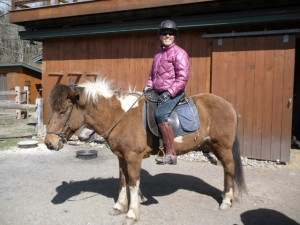
The Icelandic Riding Experience
With Karen astride Röst and Shirley on her Fleygur (please don’t ask me what their names mean!) we rode out of the yard and up a short driveway to the quiet dirt road that meanders by the farm. The scene was idyllic: tidy farm and the remaining dozen or more Icelandics (and three miniature donkeys – also wicked cute) lounging in their pastures, some lying down soaking up the sun. The barn, stables, house and pastures rest on a hillside with Vermont’s Green Mountains shooting up around on all sides, with a teensy blush of spring green on the trees and small puffy clouds chasing across a crystal blue sky. Perfect day for riding! We could just see a few white ski trails on one of the peaks at Sugarbush far in the distance. I took a deep breath and sighed contentedly.
One thing we noted right away was how easily managed these horses are compared to others we have ridden. The Icelandics ambled along amiably in pairs.Typically when you go on a trail ride you also receive instructions on where your horse falls into the queue, (The bay will only follow the paint, that the pony has to go last or gets upset, and so on). But we didn’t have to worry about any equine pecking order on this day. We rode single file, in any order, in every mix of ones, twos, threes, or fours, all quietly and with no fuss – like bumper ponies bouncing off each other harmlessly! By no fuss I mean the horses exhibited no irritation in relation to each other. They didn’t pin their ears back or attempt to nip, there was no tail swishing as a warning to stay away, and no staring and baring teeth. Even if this lack of assertiveness in establishing a pecking order were the only admirable trait we found in their characters, I already loved them dearly for it. I felt totally at ease.
Learning to Tölt
After about ten minutes with the horses stepping purposefully forward in a ground-covering walk, Shirley asked us if we wanted to try the tölt? Now most horse walk, trot or canter. These Icelandics can also tölt – a very smooth four beat gait where there is always at least one foot on the ground and that foot acts as an anchor to offer a bounce-free ride. It’s similar to the running walk of a Tennessee Walker—like fast trotting with no jolting. Additionally, some Icelandic Horses are five-gaited, also showing the “flying pace,” a lateral racing gait where the horses can reach up to 30 mph.
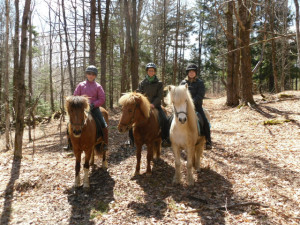
Yes!, we definitely did want to tölt! Shirley instructed us to gather up our reins a little more securely, then she urged Fleygur into a tölt, Karen asked her Röst, and our mounts followed. Suddenly, I was tölting for the first time, and I just started to laugh out loud. The pace was speedy and your butt jiggles a bit with the motion, but otherwise there is no riding technique needed – you are just flying forward, free and easy! Whoo hoo!
When we slowed back to the walk, I was still smiling inside.
Our trail ride continued for another 45 minutes or more. We left the road and climbed up a long, steep hill on an old logging trail, then down the other side, looping around. We appreciated the feel of these sure-footed ponies placing their hooves securely on the uneven ground, while we atop their backs could look around, duck a branch, or chat with our companions. Karen and Shirley had each visited Iceland and seen and experienced how these horses are bred and raised. They knew their history – how the Vikings first brought them to the island aboard their ships to be used for overland transportation. Muffy and I plied the women mercilessly with questions and learned many interesting facts about this fascinating breed (unfortunately too much to tell in this narrative). They are bred to work and socialized in ways specific to Iceland’s terrain and climate. That brings out all the characteristics that make them such good riding partners. Plus, Muffy and I both agree, they are just naturally smart and seem to love having fun!!
We eventually returned to the farm and Lucy met us in the corral. After we’d dismounted from Skotta and Rauthka and removed their tack, Lucy led them to the pasture where they clearly enjoyed a roll in a dry, sandy spot and a bite of hay. “Life is good,” they seemed to say, and we couldn’t have agreed more. .
Why Ride Icelandic Horses? Why Ride Horses?
We hugged our new pals (the humans) and said good-bye. What an incredibly fun experience we had just enjoyed. That’s why we ride horses!
Muffy is a farmer’s daughter who grew up with animals in Vermont. She’s also a seasoned instructor and veteran organizer and ratings judge in the U.S. Pony Club system. And she’s also a grandmother teaching her own granddaughter to ride. Combine all that experience, and she’s uniquely qualified to tell you some of the reasons we feel horse riding makes a good family adventure, and in particular why the Icelandic Horses are ideal for this.
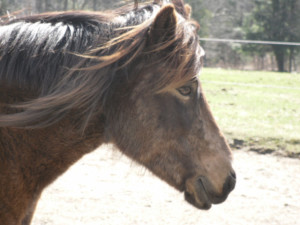
Riding the Icelandics
by Muffy Howard
I was really looking forward to riding the Icelandic ponies, although my only experience with them was seeing them from afar. They had already impressed me with their speed in their signature gait and their seeming zest for living, tearing around an arena with reckless abandon. In person they were cute to look at and friendly little creatures, but it wasn’t until I was onboard and headed out on the trail that I truly made the connection. They do indeed have a zest for life and they also like to motor right along. Unlike the usual stable horses, they know their job and they do it eagerly, well and safely. Lazy they aren’t. This gives you a great sense of confidence as a rider.
Because of the marvelous personality of these ponies, I have no hesitation in recommending an Icelandic trail ride to old and young alike. Being out in nature on a sturdy pony is much different than being on wheels, motorized or otherwise. You have a buddy to share the ride with. You can travel along in comfort (the Icelandic saddles are great) talking with your friends and enjoying the day. It is a great adventure, especially for spring and fall, when the days are cool and the bugs are elsewhere. The guides at the farm regale you with the history of this ancient breed, which helps you understand why they are so good at their job. Most fun of all, you can have the excitement of the tölt, which, as Barbara said, makes you want to laugh out loud.
So get out and give it a try. I can hardly wait to go again. Next time, I’ll bring my eight year-old granddaughter who does have some riding experience. Her own pony is very hard to get going, so I’m sure she will enjoy these zippy little critters!
If You Go
The Vermont Icelandic Horse Farm offers trail rides year ’round and this is a great add-on if you are in the area for skiing at Sugarbush (see a resort review here), or Mad River Glen, cross-country at Ole’s or Blueberry Lake, sledding at Lincoln Gap, or any of the myriad summer adventures you can enjoy in the Mad River Valley.
The folks who run the Horse Farm also run Mad River Inn, which offers special “Bed & Breakfast & Bridle packages” and Inn-to-Inn horseback treks.


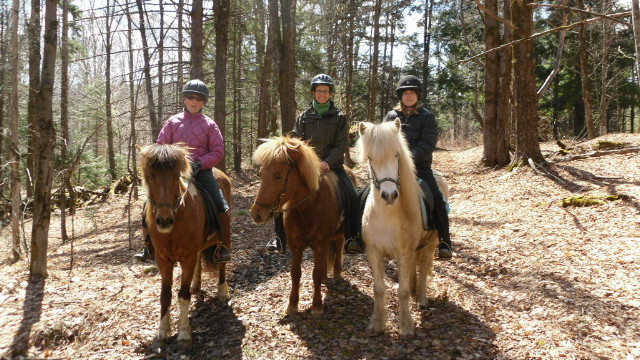
Loved this article about the Icelandic
Ponies and can’t wait to give it a try!
I hope you do! Remember to wear sturdy, flat shoes with a regular heel (or cowboy boots), comfy slacks that don’t have a thick seam running down the inside of the leg or a big knot of seams meeting in the crotch. You might also want some thin leather gloves. Helmets are available at the Vermont Icelandic Horse Farm. Take your camera!
I know you’ll have a lot of fun 🙂